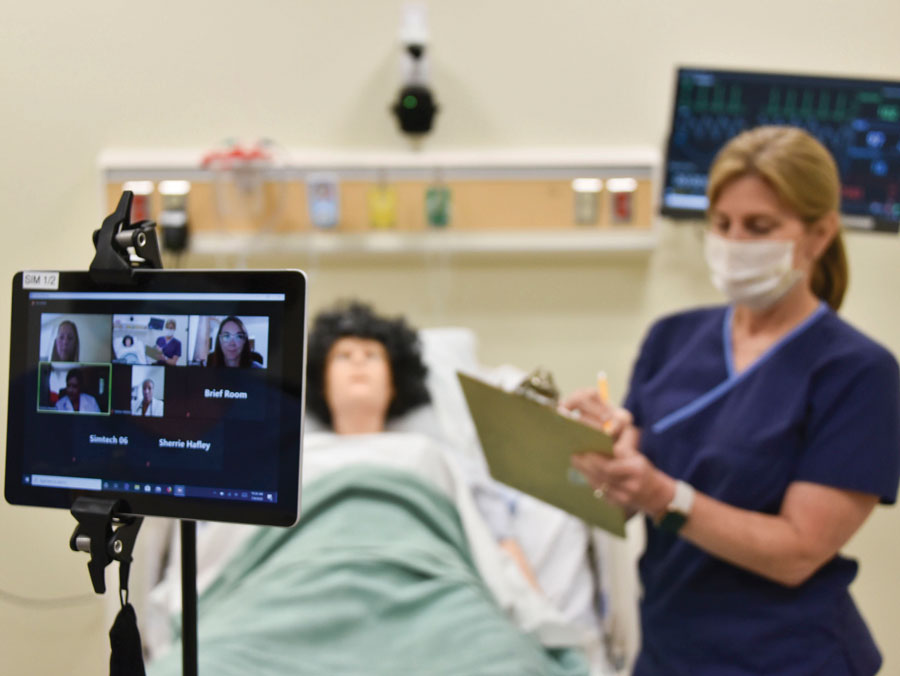 Recognized for sustaining excellence across its tripartite mission, the UAB School of Nursing uses the latest educational and health technology to lead teaching, research and practice innovation — and to engage the students, patients and populations it serves.
Recognized for sustaining excellence across its tripartite mission, the UAB School of Nursing uses the latest educational and health technology to lead teaching, research and practice innovation — and to engage the students, patients and populations it serves.
Today’s health care environment is increasingly complex, driven by the quest for quality, new technology, population health and health equity. This determines how and what health care is delivered across a continuum of settings, and nursing stands at the front line of care delivery be it in the hospital, home, work, school, community or office.
And in health care, technology is more than just the latest equipment. It’s a way to track patient progress, expand access to care, collect data and so much more.
“Technology is a central, driving force in health care delivery, and we’re going to continue to see its influence expand in the coming years and decades,” said Professor and Associate Dean for Technology and Innovation Jacqueline Moss, PhD, RN, FAAN. “That’s one of the many reasons why technology and innovation are so central to the UAB School of Nursing. The technology in our building allows faculty to bring clinical and didactic material to life for students, and it allows students to gain hands-on experience with the technology they’ll encounter in the field.”
Motorhomes to mp3s
The School has been an innovator in delivering nursing education via a distance-accessible and technology-driven format for more than 40 years. The origins of distance education can be traced back to technology that seems simple compared to today’s Zoom meetings or computer-based simulations. In the 1970s, Professor Emerita Jean Kelley EdD, RN, would travel in a motorhome, bringing graduate nursing education to nurses throughout the state and the South. This reach extended as instructors traveled across Alabama with a set of prerecorded lectures housed on VHS tapes and would leave the tapes for remote students to view.
The more modern technological steps came with the Internet. During Dean Rachel Booth’s tenure at the School of Nursing, she recognized the importance of technology leading into 21st Century learning. Her futuristic thinking and dedication to distance-accessible education using online learning platforms forged a path for the whole University.
Nursing schools tend to lead the way in distance learning for their universities, Moss said, thanks to the support of Health Resources and Services Administration (HRSA) grants.
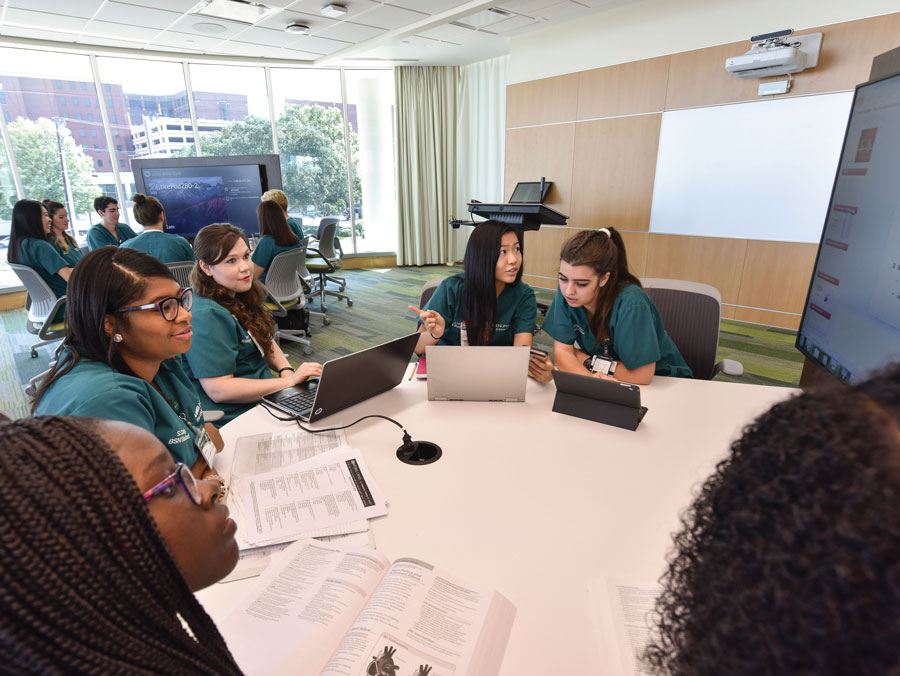 “Early on, HRSA wanted to invest in distance education for nursing because they wanted nurses to be educated in and continue to work in their communities,” Moss said. “HRSA has made a big investment over the years in schools of nursing, and that’s why nursing programs are generally on the forefront of distance education at their institutions.”
“Early on, HRSA wanted to invest in distance education for nursing because they wanted nurses to be educated in and continue to work in their communities,” Moss said. “HRSA has made a big investment over the years in schools of nursing, and that’s why nursing programs are generally on the forefront of distance education at their institutions.”
The School was the recipient of some of that HRSA funding and today it remains on the leading edge because faculty continue to incorporate innovative thinking into project development, Moss said, and the School continues to use HRSA and other funding to grow its distance accessible programs.
Booth recognized the importance of investing not only in the technology needed for distance-accessible education and online coursework, but also the human capital that allowed for adaptability and continued innovation. In 2000, she created a strategic plan for online courses and continued work with former Director of Instructional Technology Dan Murphy, who along with instructional technology staff member Charles Tomberlin, created templates and graphics for online courses and educated faculty on the proper use for courses. Success was quickly reflected in enrollment numbers. At the start, there were 60 nursing students utilizing online learning, and within about 10 years, that number grew to nearly 2,000.
When Dean and Fay B. Ireland Endowed Chair of Nursing Doreen C. Harper, PhD, RN, FAAN, came in 2005, the School built on the pathways and degree programs Dean Booth expanded, establishing more than a dozen graduate specialty tracks, and streamlined pathways to bachelor’s, master’s and doctoral degrees, while creating more opportunities for distance-accessible learning.
“After these online programs were put in place, many working nurses living in distant locations had the opportunity to continue their education at our School while at the same time holding down jobs in the communities where they lived,” Moss said. “For many of these nurses, this meant having an opportunity to further their nursing education that might not have been possible for them if they had to leave their jobs and be away from their families to move to Birmingham to study at our School.
“Innovation is so valued and encouraged at our School. Dean Harper founded and invests in the Office of Technology and Innovation establishing videographers and instructional designer positions to support faculty creativity and design thinking and learning objects that are more sophisticated,” Moss continued. “Our faculty transfer these learning principles into programs for nursing workforce development, recognizing that training is important to address workforce challenges in addition to health issues. They develop programs to address health disparities and to address gaps in care, which leads to important funding opportunities to make a difference in our communities.”
Since 2005 the School has used strategic grant writing to exponentially grow graduate distance education through more than $46 million in HRSA grants to establish educational programs related to rural health, population health and behavioral health integration. Today, the UAB School of Nursing has more than 1,500 students across the country benefiting from distance-accessible graduate and doctoral programs.
“The long-term impact of technology on distance education and along with our tripartite mission provides our School’s faculty and students with even more opportunity to continue to achieve priority goals with new strategies and tactics to address nursing’s social mandate in Alabama and beyond,” Harper said.
Today, she added, the School continues to look at expansion of distance accessible programs, especially those around educating students on how to impact health equity health care disparities, and quality care and how the School can impact those in a positive way.
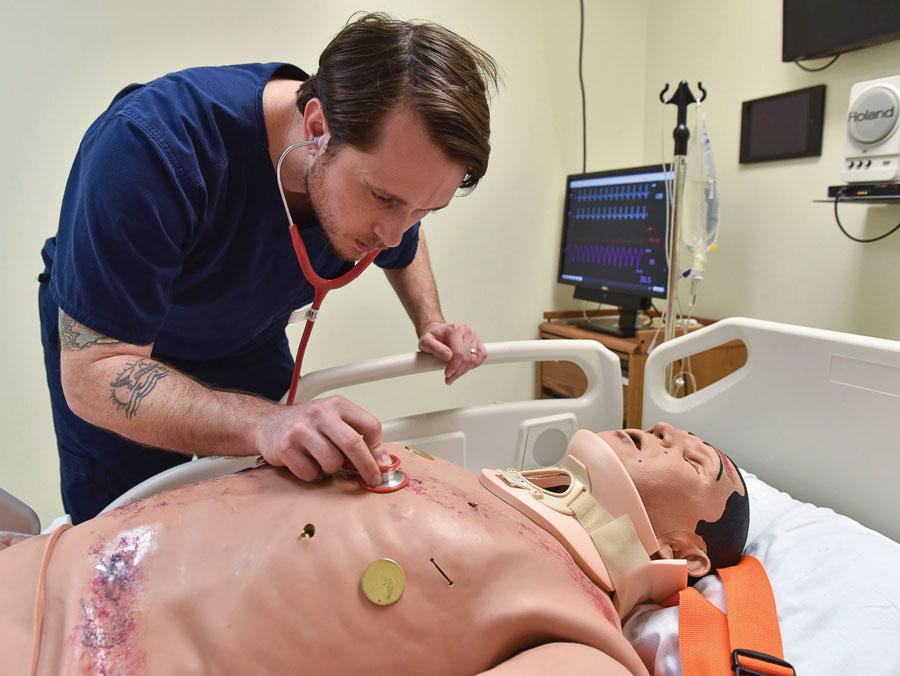 Building for the Future
Building for the Future
While the School’s 2018 renovation and expansion brought in even more technology, including a functional hospital unit, lifelike manikins for simulation, networked podiums with touch screens and classrooms designed for interaction and collaboration, technology and innovation are not new to the UAB School of Nursing. Future care delivery was also discussed.
“As plans for the School’s building expansion were developed, we used our solid foundation and looked toward the future of education as well as the future of nursing,” Harper said. “The future includes more telehealth, more advanced data management systems and constantly evolving technology, but at the root of all of our endeavors, the UAB School of Nursing remains centered on nursing’s core—care for the patients, families, and community.”
From the start, this School has worked to reach students and nurses in order to improve access to and quality of care, even if the technology in use has changed.
“As technology has become more integrated in health care, it also had to be more integrated in education,” said Senior Associate Dean for Academic Affairs Linda Moneyham, PhD, RN, FAAN. “Our investment in technology and simulation means we’re giving students an education that maintains their attention, provides them experience and sends them into the workforce prepared for anything they encounter.”
With technology, it is important to anticipate constant change, Moss said. That understanding guided the School’s plan for its 2018 expansion so that it would provide an ideal learning experience not just for a few years, but well into the future.
The guiding principles were simple—a modular design, an ability to easily update, and a focus on interactivity—these can be seen throughout classrooms and labs.
“Making things modular incorporates a flexibility in our classes and in the classroom spaces, changing them to accommodate different size groups or types of activities. The hardware and software are easily updated, and we selected equipment that allowed for a high level of interaction,” Moss said. “With our short-throw projectors, students are able to get up and write on the board while interacting with Power Points and presentations, and all classrooms are equipped with a screen-sharing software that allows students to share their device screen. Classroom design emphasizes interactivity.”
As faculty gained more experience with new equipment, they have been encouraged to continue to collaborate and innovate to produce state-of-the-art clinical and didactic learning experiences. Through regular “Coffee in the Collaboratory” meetings, faculty discuss classroom successes and challenges, and they suggest new hands-on learning experiences as well as virtual opportunities for advancement.
“Technology isn’t confined to a particular course. It’s integrated throughout the curriculum, just as technology is integrated throughout every aspect of nursing care. We strive for technology integration to be seamless,” Harper said. “Then, after graduation, students don’t have to think about the technology. It just becomes a part of usual practice, and, they can focus on patient care. With what Jackie, her team, and the faculty have created, our future and the future of the nurse leaders we educate, is limitless.”
And when discussing how technology has grown and developed at the School of Nursing especially since the expansion and renovation, Moss can sum it up in one word—“Exponentially.”
Simulation is integrated in undergraduate and graduate curriculum, meaning thousands of students pass through the bed labs, telehealth suite and skills labs every semester. The School also recently added an infusion suite to simulate the growing need for nursing care of persons receiving infusions in addition to utilizing equipment such as IV pumps, automated medication dispensing cabinets and more, students also receive a strong foundation in data and data management.
“Students used to learn about technology primarily in an informatics course or when they were in the hospital. But now data management and informatics is integrated everywhere, in every course, and in simulations,” Moss added. “For example, in our community health course, students work from our TeleCare Unit, virtually visiting a simulated patient with a new ostomy in our home health lab.”
This focus on the concepts behind technology allow students to connect their didactic and simulation experiences to the real world as we connect areas in the SON building to students virtually.
“Utilizing this technology, including lifelike manikins and state-of-the-art monitors, is not just about having something flashy to show students,” Moneyham said. “It provides the concepts, the foundation of understanding that creates nurses and nurse leaders ready to adapt to the technology and fluctuating situations they’ll encounter in their jobs.”
Education doesn’t stop in the classroom, though. The UAB School of Nursing contributes to nursing and life-long learning through mini-conferences and additional programming on the UAB School of Nursing Health Network, including CEUs through its YouTube program, Clinical Pearls, which has also developed into a new podcast offerings. These go-to brief programs engage practicing nurses in professional development with convenience and expedience.
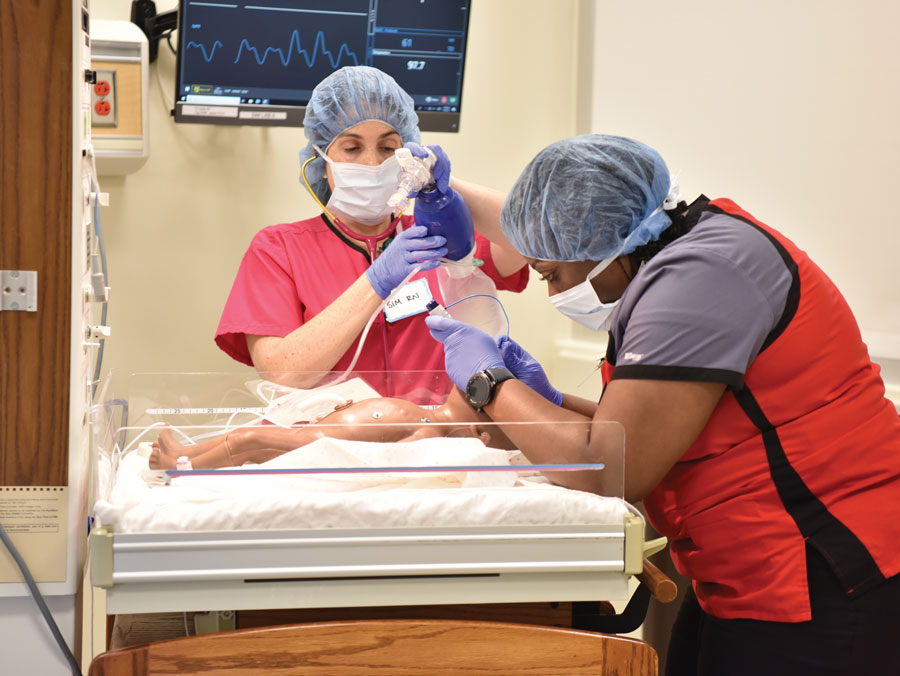 COVID-19, Technology and Three Missions
COVID-19, Technology and Three Missions
While a transition to remote education or virtual training across all programs was necessitated by COVID-19 in 2020, the previous focus on technology and training made the transition a smooth one for education, clinical and research endeavors.
“Our undergraduate and prelicensure faculty are on the leading edge of technology and innovation and helped our School quickly pivot didactic learning to the remote setting and the implementation of unique approaches to teaching clinical skills and simulation. Clinical and continuing education moved remote seamlessly as well. We actually finished building out our eight-computer station TeleCare Unit pre-COVID,” Moss said. “That enabled us to transition all of the School’s nurse-managed clinics to telehealth so that the medically underserved populations they treat were able to continue receiving care. We have also gone on to do distance-accessible mini-conferences on women’s health, primary care and telehealth to ensure providers stay up-to-date on the latest training.”
The School successfully transitioned five community care clinics to a telehealth or hybrid model during COVID-19, in addition to adapting to no-contact supply and medication drop-offs for patients who rely on these clinics for care.
As an example, one of the School’s faculty practices also set up in the new TeleCare Unit. The School’s faculty practice with The Foundry’s Changed Lives Mobile Clinic, also an interprofessional clinic, serving men at The Foundry’s two residential facilities in Birmingham and Cullman in central Alabama, is part of The Foundry Rescue Mission and Recovery Center, a faith-based drug and alcohol rehabilitation program. Faculty took the on-site clinic and remade it as a telehealth clinic to continue to provide much-needed primary and mental health care to patients. Undergraduate students who needed to complete their spring psychiatric mental health clinical hours also participated.
Moss said Clinical Simulation Specialist Sherrie Hafley, who is leading the telehealth implementation for all of the School’s clinics, worked with The Foundry and the School’s team to ensure the clinic was a success and met the standards for secure, HIPAA compliant telehealth services.
“Our goal is to make the experience seamless for clinicians, students and patients at both ends of the internet,” she said.
Innovation and technology for several years have been woven through the School’s research efforts to create unique patient care advancements and experiences. Technology is a common modality its research teams are using to reach medically underserved populations in rural areas.
For example, Assistant Dean for Clinical and Community Programs Michele Talley, PhD, ACNP-BC, FAANP, has used gaming technology in a creative—and fun—research project focused on improving outcomes for uninsured diabetes patients at the School’s PATH Clinic. Professor Mirjam-Colette Kempf, PhD, MPH, has piloted a study using telehealth to provide mental health counseling to African American women in the rural South who cannot readily access mental health care, to improve mental health and better adherence to HIV treatment plans. Assistant Professor Pamela Bowen, PhD, CRNP, FNP-BC, has utilized text messaging and mobile notifications to motivate against African Americans to increase their physical activity and improve overall health. Assistant Professor J. Nicholas Dionne-Odom, PhD, RN, ACHPN, FPCN, is studying the effectiveness of Project ENABLE Cornerstone, a lay navigator-led, virtual or in-person community-based palliative care intervention for rural and African American family caregivers in the Southeast. And, Associate Professor Carolyn Pickering, PhD, MSN, is studying how environmental, personal and disease related factors contribute to the presentation of behavioral symptoms in patients with Alzheimer’s disease using daily, virtual diary entries that track symptoms, activities and other environmental factors.
And with the COVID-19 pandemic, even research projects not heavily using remote and online technologies were able to pivot to keep studies moving, thanks to the technology available at the School.
“Most of our investigators have been able to transition to remote research and others have transitioned to a hybrid format to ensure patient safety,” said Interim Associate Dean for Research and Scholarship and Marie O’Koren Endowed Chair in Nursing Marie Bakitas, DNSc, CRNP, NP-C, ADCN, ACHPN, FPCN, FAAN. “This is a testament to the hard work of our faculty, staff and students in both offices who worked hard both before COVID-19 and once it hit to make this happen, and it has helped spur a number of ideas for new projects moving forward.”
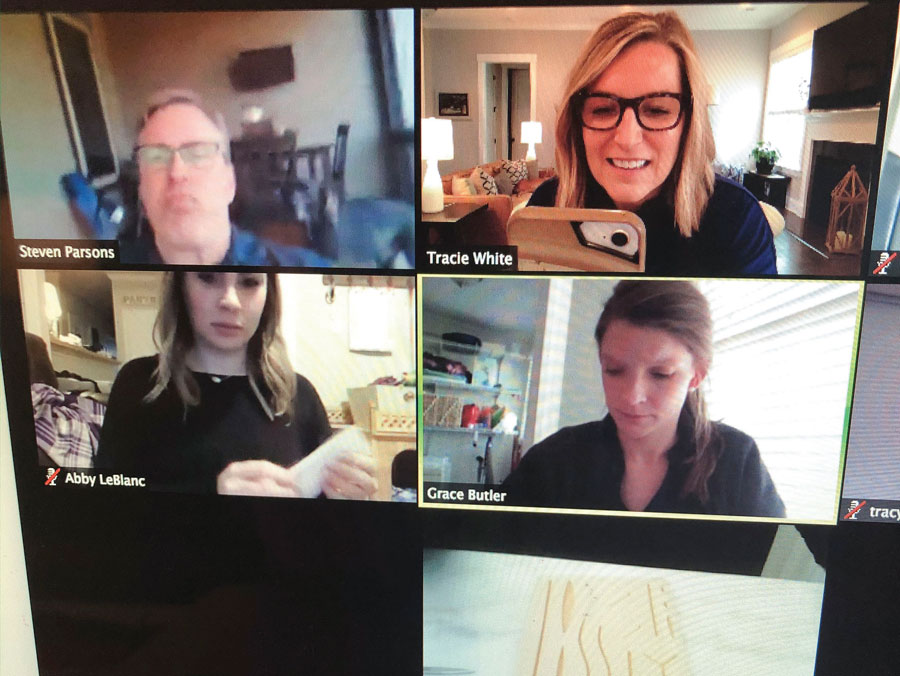 Leading the Future
Leading the Future
The School has long been on the forefront in adapting the latest technology into its missions and developing the innovations that are creating the knowledge and setting the standards of care that are transforming nursing practice, education and research.
The School continues to incorporate the latest virtual technologies into its curriculum to ensure students are highly engaged in their learning and are prepared to use technology to care for increasingly complex patients in communities.
The future expansion of virtual and digital technology will play a dominant role in the School’s clinical practices and research to eliminating health care disparities and health inequities.
“Telehealth and other innovation and technology have become essential to change,” Harper said. “From the classroom to home, the bedside to community, UAB faculty, students and alumni are driving the future of nursing, education and health care through innovation and technology opening up access, caring and inclusivity for people—students, faculty, staff, alumni, patients, families and populations—wherever they are.”
